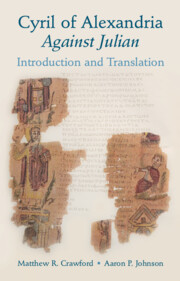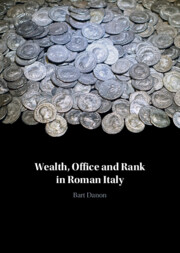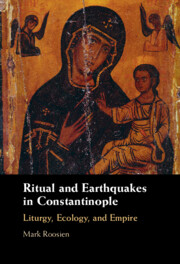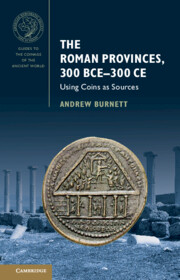Refine search
Actions for selected content:
174 results
2 - The Western Networks of Palmyra
-
-
- Book:
- Palmyra, the Mediterranean and Beyond
- Published online:
- 21 October 2025
- Print publication:
- 16 October 2025, pp 21-32
-
- Chapter
- Export citation
Economic Change in the Mediterranean between the Principate and Late Antiquity
-
- Journal:
- European Journal of Archaeology , First View
- Published online by Cambridge University Press:
- 29 September 2025, pp. 1-18
-
- Article
-
- You have access
- Open access
- HTML
- Export citation

Cyril of Alexandria: Against Julian
- Introduction and Translation
-
- Published online:
- 26 September 2025
- Print publication:
- 16 October 2025

Wealth, Office and Rank in Roman Italy
-
- Published online:
- 23 July 2025
- Print publication:
- 17 July 2025
-
- Book
-
- You have access
- Open access
- Export citation
Introduction
-
- Book:
- Wealth, Office and Rank in Roman Italy
- Published online:
- 23 July 2025
- Print publication:
- 17 July 2025, pp 1-11
-
- Chapter
-
- You have access
- Open access
- Export citation
Chapter 16 - Mars Is Oggún
- from Part IV - Transcreating
-
-
- Book:
- Latinx Literature in Transition, 1444–1886
- Published online:
- 06 August 2025
- Print publication:
- 17 July 2025, pp 363-386
-
- Chapter
- Export citation
11 - Selections from Book 16 of the Theodosian Code
- from Part II - Forming and Overseeing the Community
-
-
- Book:
- The Cambridge Edition of Early Christian Writings
- Published online:
- 19 May 2025
- Print publication:
- 12 June 2025, pp 180-198
-
- Chapter
- Export citation
1 - The Nature of Roman Imperialism
-
- Book:
- The Romanization of Britain
- Published online:
- 02 January 2025
- Print publication:
- 16 January 2025, pp 1-8
-
- Chapter
- Export citation
5 - City Networks in the Roman Empire
-
- Book:
- World Cities in History
- Published online:
- 12 December 2024
- Print publication:
- 19 December 2024, pp 96-124
-
- Chapter
- Export citation

Ritual and Earthquakes in Constantinople
- Liturgy, Ecology, and Empire
-
- Published online:
- 05 December 2024
- Print publication:
- 14 November 2024
New approaches to the architectural design, amenities, and function of macella: typologies, scale, and the Macellum Magnum
-
- Journal:
- Journal of Roman Archaeology / Volume 37 / Issue 2 / December 2024
- Published online by Cambridge University Press:
- 27 January 2025, pp. 478-507
- Print publication:
- December 2024
-
- Article
-
- You have access
- Open access
- HTML
- Export citation
Recycling and repair on the Roman frontier: a hoard of mail armour from Bonn
-
- Article
-
- You have access
- Open access
- HTML
- Export citation
Chapter 5 - Liturgical Aestheticism
-
- Book:
- Liturgy, Ritual, and Secularization in Nineteenth-Century British Literature
- Published online:
- 14 November 2024
- Print publication:
- 21 November 2024, pp 127-147
-
- Chapter
- Export citation
On Guelfs and Ghibellines
- from Texts
-
- Book:
- Bartolus of Sassoferrato
- Published online:
- 14 November 2024
- Print publication:
- 21 November 2024, pp 3-15
-
- Chapter
- Export citation
3 - A Tale of Two Fatherlands
-
- Book:
- Nations before the Nation-State
- Published online:
- 14 November 2024
- Print publication:
- 21 November 2024, pp 47-75
-
- Chapter
- Export citation
9 - Selling Empire
- from Part III - Collapse
-
- Book:
- Three Consuls
- Published online:
- 31 October 2024
- Print publication:
- 21 November 2024, pp 239-267
-
- Chapter
- Export citation

The Roman Provinces, 300 BCE–300 CE
- Using Coins as Sources
-
- Published online:
- 14 November 2024
- Print publication:
- 14 November 2024
-
- Textbook
- Export citation
Chapter 4 - Earthquakes and the Saints
-
- Book:
- Ritual and Earthquakes in Constantinople
- Published online:
- 05 December 2024
- Print publication:
- 14 November 2024, pp 108-134
-
- Chapter
- Export citation
Chapter 2 - Earthquakes and Emperors
-
- Book:
- Ritual and Earthquakes in Constantinople
- Published online:
- 05 December 2024
- Print publication:
- 14 November 2024, pp 52-74
-
- Chapter
- Export citation
Chapter 3 - Beyond Divine Chastisement
-
- Book:
- Ritual and Earthquakes in Constantinople
- Published online:
- 05 December 2024
- Print publication:
- 14 November 2024, pp 75-107
-
- Chapter
- Export citation
